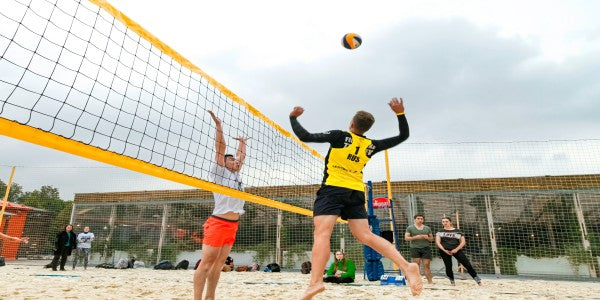Beach Volleyball Rules: Everything You Need Know
Beach volleyball is a popular beach activity that can range from leisurely to competitive league matches to an Olympic competition. In a formal setting, there are specific rules that govern the action. This article covers beach volleyball rules and standards for play.
Indoor versus Beach Volleyball
There are a few key differences between indoor volleyball and beach volleyball. The indoor game is played on a hard court with six players per team. In beach volleyball, there are only two players per side, and played on sand. In both versions, the match starts with a toss of the coin to determine who serves first.
Fundamental Concepts of Beach Volleyball
Keep the Ball from Dropping on Your Side of the Net
The main focus in volleyball is to land the ball on the sand on the opponent's side of the court while keeping it off the sand on your side. With only two players per side in beach volleyball, the effort needed to prevent the ball from hitting the sand is extreme.
Two Players Per Team
With only two players per side, serving is alternated. To cover the entire court with two players, teammates are generally compatible according to their skill sets. An example would be one player who is excellent at passing teamed with one who isn’t as proficient or an outstanding server with a mediocre server.
Three Hits Allowed per Side
Both indoor volleyball rules and beach volleyball rules allow at most three hits to get the ball back over the volleyball net. Generally speaking, a dig is the first hit, followed by a set, followed by a spike. A dig is a pass using the forearms. The set is an overhead pass back to the digger, who spikes the ball with great force over the net using a one-handed overhead motion.
The opposing team can block the ball as it comes back across the net. Should a player block the ball and keep it on their side of the net, they will still have three additional hits to return the ball to the opponent’s side.
Additionally, beach volleyball rules prohibit players from carrying, palming, or throwing the ball back over the net. Volleyball in its purest form is a rebound sport, in the sense that the ball bounces or rebounds off the arms or hands and never comes to rest until it hits the ground.
A Player is Prohibited from Striking the Ball Two Times in a Row
Beach volleyball rules do not allow players to hit the ball more than once in succession. The only exception to this rule is if the double contact takes place as the first contact, but only if the intent is to hit the ball once. A player cannot, for example, set the ball for themselves and then spike the ball over the net. In this case, there is a clear intention to hit the ball twice.
Touching the Net is Prohibited
Teams are allowed to play the ball out of the net but players cannot touch the net with their uniform or any part of the body. A player is not penalized for touching the net as a direct result of a ball being struck into the net. While rarely seen in game action, players are allowed to go under the next but only if it doesn’t hinder the opposition’s efforts to hit the ball.
Rules for Game Play
Similar to tennis, beach volleyball matches are divided into sets where a team must win two of three sets (or games) to win the match. The winner of the initial coin toss decides to serve first or receive first. The serve alternates between teams over the next sets.
Unlike indoor volleyball where the first team to 25 points wins a game, 21 points are needed to win a game under beach volleyball rules. The stipulation is that a team must win by two points, so oftentimes games got beyond the set 21-point mark before being decided. Should a match go to the third set, then 15 points determine the winner of the game.
During a set, each team is allowed a single time-out. In addition, there is a time-out called by the referee after each set to give teams a few minutes to rest before the next set begins. Also, note that teams will switch sides after every seven points are scored. This switch occurs every five points during the third set tiebreaker.
Even though beach volleyball is a strenuous game, substitutions are not permitted under beach volleyball rules. Therefore, if a player is injured to the point of not being able to continue, the team must forfeit the match.
Serving
When serving, a player can move anywhere behind the end line of the court. When the ball is struck on the serve, the player’s foot is forbidden to cross over the end line until after making contact with the ball. The server is given only five seconds to make the serve after receiving the ball from the referee. Beach volleyball rules allow the server to hold the ball with one or both hands, but can only make contact with the ball with one arm or hand.
Should the ball fail to get over the net on the serve or the opposing team returns the ball that hits in the serving team’s side of the court, the other team gets a point and the next serve. However, should the serving team win the rally, the same player serves again. Therefore, in theory, the same person could serve for an entire game.
Court Size and Equipment
Beach volleyball courts are rectangular and measure 16 meters by 8 meters. This is two meters shorter in length and one meter shorter in width than indoor courts. The court it divided by a center line and a net which is 2.24 meters high for women and 2.43 meters high for men.
A standard beach volleyball must weigh between 260 and 280 grams (9.2 to 9.87 ounces) and have a circumference between 66 and 68 cm (25.98 to 26.77 inches).
Scoring
Beach volleyball rules and indoor volleyball rules are identical regarding scoring. Simply put, a point is scored at the end of each rally which occurs when the ball hits the ground. A team does not have to be the serving team to score.
Basic methods of scoring include striking the ball towards an opponent with weaker return skills, aiming to land the ball in unoccupied spots, spiking the ball very close to the net, serving an ace, or simply catching the opposition off guard with a tip over the next.
Whether you plan on participating in beach volleyball or simply watching a match in person or on television, understanding beach volleyball rules will make an already exciting game more enjoyable.







